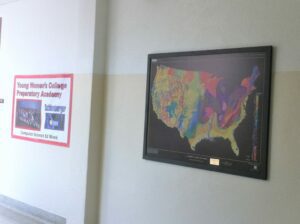Maps In Schools - Overview
Inspired by the leadership of our late colleague, Owen Hopkins, #2986, from Corpus Christi, the Houston SIPES Chapter began placing USGS geologic maps of the U.S. lower 48 states in local schools in 2009.
Several maps have been presented as rolled paper maps, along with oral presentations by Pat Shannon, #2195, Duncan Dubroff, #2618, myself and other SIPES Members. The map itself, called “A Tapestry of Time and Terrain” is a creation of the USGS. It is a large, colorful, even dramatic geologic map with shaded topographic relief of the continental U.S., color coded to the geologic column, and an absolute time scale beside the map. The SIPES Houston Chapter now frames the map professionally and adds a brass dedication plate describing the origin of the gift honoring Owen Hopkins, and more recently, our late past Chapter Chair John Hankey, #2548.
Would You Like to Contribute?
SIPES Houston has had an outreach project since 2009 donating framed geologic maps of the United States to schools, primarily in the greater Houston area.
Each of these maps cost $400 - so the more money raised, the many more schools who will have beautiful maps and an educational opportunity from industry vets!
Outreach Goal
The purpose of our outreach is to have the informative and colorful geologic map serve as a focal point for students, visible in a classroom, hallway or lab, and perhaps stimulate interest in earth science and careers in earth science. This map is created by the United States Geologic Survey from space photography and shows the interpreted geologic age of the bedrock color coded to the geologic column.
The Houston Chapter of SIPES has now presented over 20 maps, and made over 30 presentations (several repeat visits to schools with a map from a prior visit). We have gone primarily to public and private middle schools, high schools and notably to three HISD and one Fort Worth ISD “Energy Institute” high schools with STEM programs supported by IPAA. We have also made presentations at San Jacinto Junior College, the University of Houston and to the River Oaks Women’s Breakfast Club! Besides Fort Worth maps have been sent to a schools in Tulsa and New York City.
How It Started
“Maps in Schools” is a major outreach program of the SIPES Houston Chapter which began in 2009.
The Houston Chapter effort was inspired by the Corpus Christi SIPES Chapter, the Corpus Christi Geological Society and the leadership of our late colleague, Owen Hopkins. Following their lead, the SIPES Houston Chapter began placing USGS geologic maps of the lower 48 in local schools in 2009. Several maps were presented as rolled paper maps, along with oral presentations by Pat Shannon, Duncan Dubroff and myself.
The map itself, called “A Tapestry of Time and Terrain”, is a creation of the USGS. The map is a large, colorful geologic map with shaded topographic relief of the continental US, color coded to the geologic column, with an absolute time scale. SIPES Houston now frames the map and adds a brass dedication describing the origin of the gift and honoring Owen and more lately, our past Chair, John Hankey. Since 2009 more than 30 schools (mostly in greater Houston) have received framed maps, had a lecture on the geologic phenomena the map illustrates and in several cases, asked for repeat presentations. Maps have been placed in Middle and High Schools.
Initially, progress was slow, largely as a result of the reluctance of schools to understand we had a message of significance and the “red tape” administrations deal with in the current environment of bad things happening in schools. Covid has slowed down the ability to visit schools dramatically.
So What Do We Say In the Presentation
The presentation we make at each of the schools consists of five parts:
- Introductory Comments: What is Earth Science and Why is SIPES Giving Your School a Map?
- DVD: the AGI DVD entitled “Why Earth Science: Because We Live on Earth” which is a very professional 10 minute overview of geoscience including volcanoes and dinosaurs
- PowerPoint Presentation: 25 slides describing the geologic map, features observable on the map, geologic time, careers in geoscience and fossils. A new addition is discussing William Smith using the book “The Map That Changed the World” written by Simon Winchester. A copy of the book is donated to the school.
- Fossil Collection: a quick review of a few of my personal fossil collection and how fossils help define geologic time periods
- Questions
Click on a photo to view larger.














